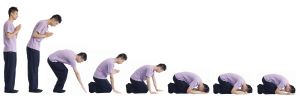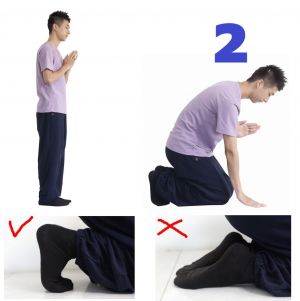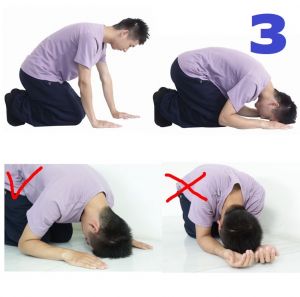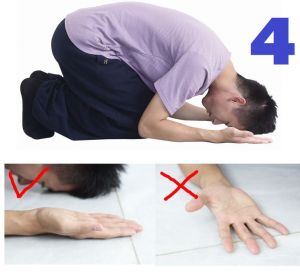Practice Method of Prostrating to the Buddha
Prostrating to the Buddha is the way for Buddhists to express respect and gratitude to the Three Jewels of Buddhism: the Buddha, the Dharma and the Sangha. In addition to praying for the avoidance of calamities and disasters and gaining more wisdom and blessings, prostrating to Buddha mainly functions to: 1. repent of wrongdoings in the past; 2. show gratitude and homage; and 3. practice meditation.
Prostration Poses
1. Starting position: join your palms.
Body: keep the head upright and tuck in the chin. Relax your facial muscles. Keep your back straight and your whole body relaxed.
Hands: put your palms together in front of your chest and keep your body straight. Join your palms with your fingers closed, and thumbs and index fingers next to each other. Hands are at a 45 degree angle from the chest. Your arms hang naturally and relaxed at the sides. Eyes to fingertips of middle fingers. Feet: maintain the center of gravity at your feet and turn your feet outwards. Keep 2 inches from heel to heel, while maintaining a distance of 8 inches from toe to toe.
2. Bend down slowly. Left hand remains unmoved in front of your chest when the right hand reaches forward to be placed on the ground. Afterwards get down on both knees.
- The tips of the toes remain in the same place when kneeling. The soles of the feet face downward.
- Do not stretch your hands out or raise your tailbone too much. Try to kneel by lowering your buttocks onto your heels.
- Keep your whole body relaxed while bending and kneeling. The axis of your head and body should maintain a straight line to prevent headaches.
3. After both knees are lowered, gently move your left hand to the ground about half a palm further in front of the other hand. Walk with your right hand upward. Tilt your head down softly, placing your forehead on the floor between your hands.
- Touch the ground softly with your forehead, not with the top of your head.
- Keep your eyes open all the time. This is to avoid dizziness when getting up, as well as avoid injuring the head by maintaining a safe distance between the head and the ground.
- Keep your hands naturally spaced apart. The distance between them should be neither too wide nor too narrow.
4. Make gentle fists with palms facing upward, and unclasp your fingers as if your hands were to hold the Buddha’s feet like the lotus. At this stage, both knees, both elbows and the forehead are to be placed on the floor. This is known as "throwing five parts of the body to the ground", as well as "touching the ground with five body parts (arms, two legs, and forehead)".
- Move your hands only while your body and soles stay in the same position.
- Try to keep your hands flat after turning them face upwards. Fingers remain in a relaxed and neutral way.
5. Make gentle fists again and roll them over. Spread the palms flatly on the ground. Rise up and lift your forehead off the floor.
6. Place your right hand to your right knee; left hand to your chest. Lean on your right arm and lift your body off the floor. Stand up and return to the starting position.
- When prostrating to the Buddha, from kneeling down to getting up, you should always keep your feet stable and unmoving. Great Buddhist practitioners, who have engaged in a regular prostration practice in the exact same spot for a prolonged period of time, can often indent their footprint into the rock or wooden blank on which they do prostrations.
- During the breakfast period in Nung Chan Monastery, Master Sheng Yen used to teach his monastic disciples the appropriate timing to do both slow and fast prostrations. He pointed out that it is more suitable to do slow prostrations if you have a clear mind and your body is in a relaxed condition. On the other hand, if you feel very tired, you should do fast prostrations instead. Even doing prostrations only for ten minutes can relax your body, relieve your stress and tension, and help you fall asleep.
Source
[[1]]



